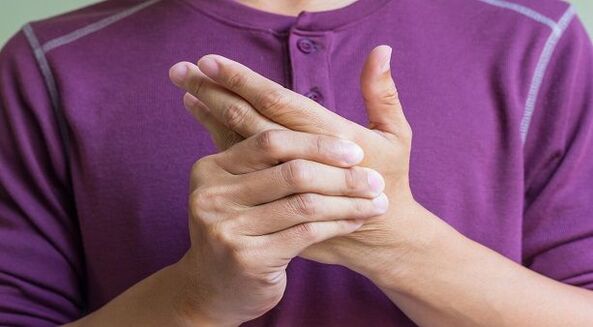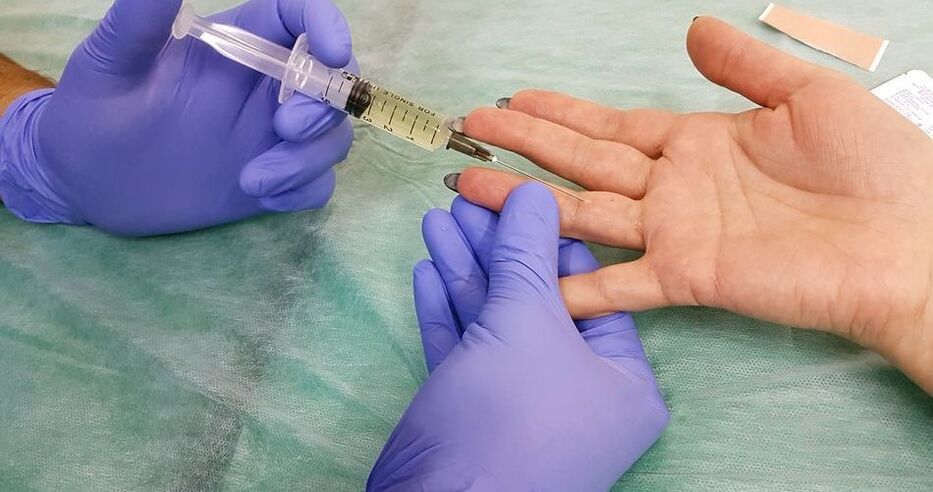Are you worried about pain in your fingers and don't know what's wrong? Perhaps this is a consequence of trauma, rheumatoid arthritis, polyosteoarthrosis or rhizarthrosis. There are other causes of arthralgia that can only be identified with the help of instrumental diagnostics.

Contact the clinic and specialists will determine the clinical picture, perform complex therapy. With the help of medications, physiotherapy, rehabilitation methods, the inflammation will be removed, the destructive processes will be stopped and the limbs will be restored to working capacity.
Why finger joints hurt: causes and treatment
Arthralgia often occurs as a harbinger or symptom of a primary disease. Acute sensations arise as a result of inflammatory arthropathies, degenerative-dystrophic pathologies, mainly of traumatic origin. Pain syndrome causes irritation of nerve endings, provoked by:
- toxins;
- sodium or potassium urate;
- bone growths;
- allergens;
- autoimmune processes.
The cause of pain in the joints of the fingers can be a neurological disease or a problem that is not directly related to the limbs. Radiating pain referred to the left limb is a common occurrence in a heart attack. This also happens with problems in the upper part of the cervical region. With an intervertebral hernia, it gives to the shoulder and forearm, hands.
However, there are a number of direct reasons due to which the phalanges become numb, the small joints of the limbs suffer. Fingers hurt after infections, hypothermia, inflammation of soft tissue structures and bones.
Rheumatoid arthritis
The disease in 7% of cases affects people over 30+. It all starts with the swelling of the metacarpophalangeal bones of the big toes. Then the catarrhal process spreads to the wrist joint, covers all structures. It touches one hand, then spreads to the other. A symmetrical lesion of the proximal nodes with a change in shape is typical for this pathology. For the company, the bones of the pelvis, ankles and feet suffer. Arthritis is characterized by rippling pain. During the day and in the first half of the night they are tolerable, in the second they intensify and do not allow sleep.
Psoriatic arthritis
It accounts for 5% of cases. The disease affects men and women equally after 20 years. For the most part, it develops in people with skin manifestations - psoriatic plaques and characteristic spots on the body. The pathology is characterized by "vertical" inflammation with simultaneous thickening of all joints. At the same time, the phalanx of the finger on the arm hurts, the skin turns red, it becomes like a sausage. Unlike rheumatoid inflammation, the process affects both hands, but affects different bones.
gout
With this problem, less than 5% of patients turn to doctors. It is about men aged 25-55 years old. Inflammation begins with the big toes, gradually rises through the joints, affects the phalanges of the hands. The pain develops suddenly. It permeates the entire limb, does not go away for a long time. The affected area becomes purple and hot to the touch. In women, the process is milder, lasting 3-10 days. However, after a while everything repeats itself. A wave-like course is a sign of the development of gout inflammation.
Arthritis
According to the collective definition, they understand articular abnormalities of a different nature. They appear as a result of past infections, with systemic diseases. Signs of acute inflammation - swelling, redness, temperature, pain in the joints of the fingers. Most often suffer metacarpophalangeal and interphalangeal. In chronic arthritis, episodic sharp sensations are distressing. Over time, muscles lose strength and function. Arthritis of the fingers leads to loss of physiological abilities and disability.
Polyosteoarthrosis
The knuckle on the hand is very sore with degenerative changes in the bones. It all begins with the thinning of cartilage tissue, damage to the spherical interphalangeal joints. The reasons lie in compression and sclerosis of the synovial membrane, endocrine abnormalities. Doctors consider primary polyosteoarthritis as an independent disease provoked by physical overload, hypothermia. Secondary - as a complication after infections and mechanical injuries. In both cases, sharp pains are aggravated, flexion contracture appears.
Rhizarthrosis or osteoarthritis
This is another cause of pain in the fingers, causing arthralgia and causing problems at the junction of the thumb and wrist. The process affects the entire node. This results in:
- to reduce depreciation;
- layer by layer abrasion and destruction of bone tissue;
- thickening in the interphalangeal area;
- the appearance of joints and hardening.
- crackling.
An orthopedic surgeon comments:
Symptoms vary depending on the stage. In people who load the big toe for a long time and monotonously, in 30% of cases, rhizarthrosis develops as an independent disease. Since the symptoms are 90% consistent with de Quervain's tenosynovitis, the problem is differentiated using an x-ray. The picture clearly shows bone deformations, and not soft tissue, as with tendon inflammation.
cause finger disease
In the medical reference book, bunion syndrome is known as stenotic ligamentitis. Symptoms: sharp pain in the finger: swelling, lump formation, numbness. What is special is the inflammation of the tendon and the formation of joints that prevent the bending of the phalanges. In the absence of therapy in stage 3, the finger takes a fixed position, in stage 4 secondary deformation occurs, the process becomes irreversible. Among the many provocative causes, anatomical anomalies of the ligamentous tendon apparatus are most often mentioned.
De Quervain's tenosynovitis
Due to de Quervain's disease, the bones in the fingers hurt in 4% due to muscle inflammation. Sharp sensations occur suddenly at the junction with the wrist joint and are aggravated by bending. The pathology leads to damage to the synovial membranes of the extensors of the fingers. The problem is reduced by monotonous movements, due to constant pressure on the hand and palm, causing cicatricial changes in the ligament. She:
- playing keyboard instruments;
- oppression;
- work on the conveyor.
Raynaud's syndrome
Fingers hurt due to a sharp vasoconstriction due to systemic diseases - vasculitis, scleroderma, lupus erythematosus, blood diseases, compression of blood vessels and nerve fibers. Vasospastic pathology is associated with paroxysmal blood circulation disorders under the influence of cold temperatures. The clinical syndrome does not appear for years. Over time, attacks appear that cause whitening or reddening of the skin, cyanosis. As a result, symptoms lead to trophic changes in soft tissues.
carpal tunnel syndrome
Finger joints also hurt due to injuries and the development of carpal tunnel syndrome. Unsuccessful fall, impact provoke damage to the integrity of tissues, blood vessels, lead to the formation of a hematoma or a fracture of the hand. The development of the syndrome is facilitated by compression of the median nerve under the ligament that holds the tendons. Clinical manifestations: numbness of the palm, decreased motor skills, decreased muscle volume in the greater tubercle. Diseases associated with inflammation of tendon fibers are more common in women.
The bones in the fingers hurt:
- Due to bursitis of various forms.
- Childhood anomalies - Still's disease, Kawasaki syndrome.
- Systemic diseases - diffuse fasciitis, Lyme, Sjögren's, Crohn's, Bechterev's diseases.
- Tumors - myeloid disease, lymphoblastic leukemia.

Diagnosing
It is impossible to determine why the fingers on the hands hurt without a differential examination. First, a visual inspection is performed. A rheumatologist or arthrologist pays attention to the symmetry of the lesion, symptoms and other clinical signs. The patient is consulted by a traumatologist and an allergist and then sent for laboratory tests.
Blood biochemistry determines rheumatoid factors, levels of uric and sialic acids, the rate of sedimentation of erythrocytes in the blood. In infectious and immune pathologies, a reactive protein is detected, indicating tissue destruction.
Why do the fingers on the hands hurt, the cause and treatment help to establish radiography, ultrasound. The doctor examines problematic structures, performs a symmetrical diagnosis of a healthy hand. Necessary:
- to assess the degree of damage to structures;
- condition of cartilage and ligaments;
- detection of primary signs of anomalies, cysts and nodes.
MRI is prescribed for suspected degenerative and neoplastic diseases. Tomography helps to obtain 3D images of soft tissues in different projections, to identify recent and chronic injuries. Informative methods show displacement, joint space width in arthritis, cartilage thinning in arthrosis, bone displacement, growth. Sometimes densitometry is prescribed to determine bone density.
Because the phalanges of the fingers hurt, they will suggest other research methods - electrospondylography and electroneuromyography. The first technology detects the part of the spine responsible for limb movements. The second determines the condition of peripheral muscles and nerves. With throbbing pain in the finger, a specialist may recommend a splint. The percutaneous aspiration method allows you to take a secretion, at the same time administer an antibiotic or analgesic to relieve acute symptoms.
Diagnosing
- Ultrasound diagnostics.A non-invasive study is indicated for inflammation and damage of soft tissues, muscles, ligaments, tendons, joint capsules using ultrasonic waves.
- Radiography.Assign for injuries: dislocations and fractures of bones, joint diseases: arthrosis and arthritis of the joints.
- Analyzes.General analyzes of blood and urine, blood biochemistry show signs of inflammation, presence of infection, disorders in bone and cartilage tissue.
- Magnetic resonance imaging.A high-precision method for diagnosing nodes with information content of up to 99%.
Finger pain: causes and treatment
Regardless of the etiology, NSAIDs are prescribed to relieve acute sensations, fever, inflammation. Effective: nimesil, phenylbutazone, indomethacin, teraflex, diflofenac sodium. If the knuckles are very sore, ketorolac and tenoxicam are suitable for treatment. With a drip or intramuscular infusion, they remove the symptoms for 3 days.
Corticosteroid drugs - dexamethasone, prednisolone also relieve the catarrhal process. At the same time, the swelling decreases, the metabolic processes in the cartilage improve, which contributes to the rapid restoration of mobility. Chondroprotectors thicken the structure of bone tissue, prevent deterioration of degenerative processes.
Physiotherapy - ultrasound therapy and electrical impulses, acupuncture improve blood circulation. Therapeutic gymnastics helps to develop muscles, restore joint mobility. Patients are advised to review their diet, eat a diet with a predominance of protein and plant foods, and undergo spa treatment.
Methods of Treatment
- Waiting for a traumatologist-orthopedic
- Handheld shock wave therapy
- Plasmolift of joints
- PRP therapy for the wrist
- Wrist joint block
- Brush injections
- Phonophoresis
- electrophoresis
- Ultrasound of the hand
- Physiotherapy
- Drug therapy
- Orthotics
- Magnetotherapy

























